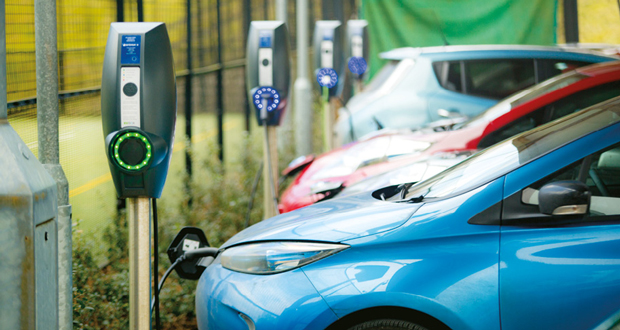 If the UK is going to move toward net zero by using more EVs then it needs a charging infrastructure to meet demand and FMs hold the key. David Harris, VINCI Facilities Customer Director explains
If the UK is going to move toward net zero by using more EVs then it needs a charging infrastructure to meet demand and FMs hold the key. David Harris, VINCI Facilities Customer Director explains
The electric vehicle (EV) market is booming. Which means the corresponding charging infrastructure must keep pace. Electric car sales increased by 186 per cent in 2020 and EVs enjoyed another record year in 2021 with more than one in 10 new vehicles being electric. In 2021, annual demand for second hand EVs hit a new record, increasing by 119.2 per cent with 40,228 second-hand electric cars being sold. Today there are an estimated 477,000 electric cars on the road in the UK and more than 790,000 plug-in hybrids (PHEVs). Alongside that, organisations of all kinds are switching their fleets to electric. Registrations of electric vans in September were up 70 per cent on 2021.
By the time the UK ban on new petrol and diesel vehicle sales in 2030 goes live, we estimate that one in five vehicles will be electric.
NEED FOR POWER
But how do we power these vehicles? Data from Heycar, obtained via the DfT and SMMT, claims there are 33,996 public electric vehicle charging devices available in the UK. Of these, 6,236 are rapid EV chargers. Scotland has the highest number of EV charging devices per 100,000 of the population (47), followed by England (36), Wales (29) and Northern Ireland (17).
That is not enough. Despite a big investment in the UK’s charging infrastructure, there is much more to do to create a reliable network of charging systems for EVs. The network will be a mix of on street charging planned and permitted by local authorities, charging in retail parks, car parks and service stations as well as workplace charging for offices, manufacturing, healthcare and logistics operators. So, who is going to do this work? Facilities managers, of course. Why not? It is a massive market and one that fits with the core of what FM is about – enabling productivity and reliability.
Putting aside the lack of charge points, when EV drivers do find one where they need it the biggest issue is downtime – they are often not operating. The existing charging infrastructure is under a lot of stress – and it is not reliable. This is sometimes due to remote software issues, but equally, down to hardware – and both can be overcome by planned and reactive maintenance regimes. And who is best at that? The facilities management profession.
FM SOLUTIONS
FM services in offices, schools, hospitals and commercial spaces, is always done best when FMs have been involved in the design and planning of a facility. That is the same with an EV charging infrastructure. That is why VINCI Facilities is advocating an end-to-end solution. Some of our clients buy into all of it, or part of it – for example we maintain EV assets for Shell. They have plans to have 100,000 EV assets by 2030 as it sets up charge points at its service stations, in car parks and supermarkets.
Shell, DHL, Amazon, and others are the tip of the iceberg. Each has a different approach, its own targets and respective target end users. But all of them demand reliability of charge – first time. Drivers want instant power for their vehicle and the immediate ability to pay for it by a cashless transaction.
Paythru, a payment technology company in the EV sector, argues that finance, and specifically cashless mobile payment, can drive transformative change. A smart seamless payment experience for EV charging and parking offers the potential to both drive EV adoption and significantly reduce greenhouse gas emissions across the UK. This is important for any charge point operator wishing to obtain revenue. But only if the charge point is working. Only if it has the correct access to power. A seamless payment system, even one that combines parking and charging, is only as good as the maintenance regime underpinning the infrastructure.
EV ATTRACTION
For employers seeking to make their workplace an attractive destination by providing free to use EV chargers or a retail, or a business park looking to increase footfall via free charging, ease of payment is not an issue. The consistent factor is fast, easy, available charge time – not downtime.
Hard to convince mobile engineers, delivery drivers, as well as the public, will not be persuaded to adopt low-zero carbon EVs if they cannot access the power. So, you need experts, like us, who can survey your site, design the set-up, install it and then maintain it for you. And it is not just about build it, plug it in and go.
The Energy Super Hub at Oxford offers fast and ultra-rapid charging for 42 vehicles at once at Oxford’s Redbridge Park and Ride. The charging hub will be powered entirely by renewable energy. With 10MW of installed capacity on site, the hub can scale up with EV adoption to provide charging for 400 vehicles. The site is directly connected to National Grid’s high voltage transmission network via a four-mile underground cable. This will deliver 10MW of power to charge hundreds of EVs quickly and simultaneously without putting additional strain on the local electricity network or requiring costly upgrades.
This is engineering at scale that demands careful planning, design and then planned maintenance to ensure it works. There is only one sector that is skilled enough to support its clients and has the resource to deliver that type of service at scale: facilities management.





